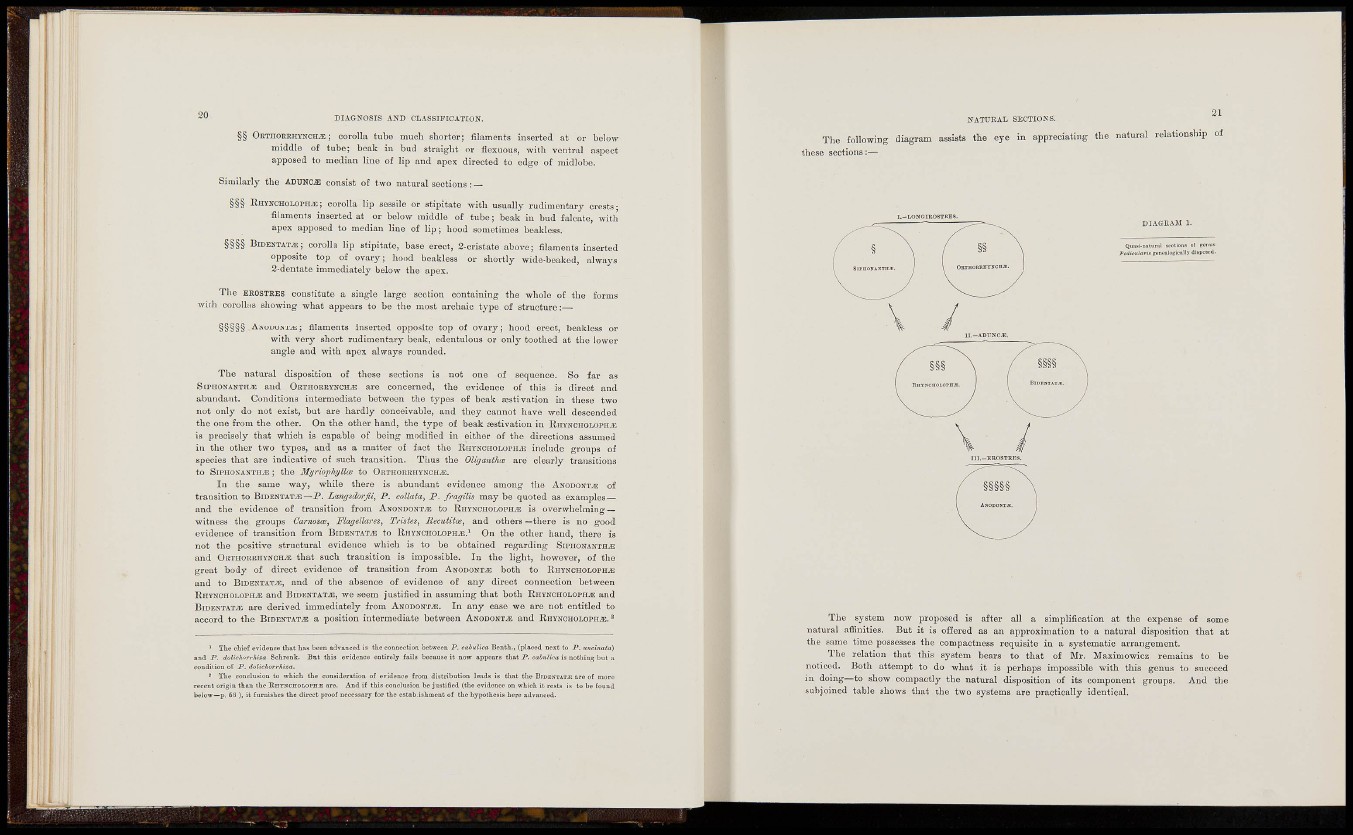
^ ^ DIAGNOSIS AND CLASSIFICATION.
§§ ORTnoREHYNCii^; corolla tube much shorter; filaments inserted at or belowmiddle
of tube; beak in bud straight or flesuous, with ventral aspect
apposed to median line of lip and apex directed to edge of midlobe.
Similarly the ADUNC^E consist of two natural sections : —
§§§ RUYNCHOLOPH-E; corolla lip sessile or stipitate with usually rudimentary crests;
filaments inserted at or below middle of tube; beak in bud falcate, with
apex apposed to median line of lip; hood sometimes beakless.
§§§§ BIDENTATJE; corolla lip stipitate, base erect, 2-cristate above; filaments inserted
opposite top of ovary; hood beakless or shortly wide-beaked, always
2-dentate immediately below the apex.
The EROSTRBS constitute a single large section containing the whole of the forms
wirh corollas showing what appears to be the most archaic type of structure:—
§§§§§ ANODONT^E; filaments inserted opposite top of ovary; hood erect, beakless or
with very short rudimentary beak, edentulous or only toothed at the lower
angle and with apex always rounded.
The natural disposition of these sections is not one of sequence. So far as
S IPHONANTFL^E and ORTHOREYNCHJ: are concerned, the evidence of this is du-ect and
abundant. Conditions intermediate between the types of beak ajstivation in these two
not only do not exist, but are hardly conceivable, and they cannot have well descended
t h e one from the other. On the other hand, the type of beak «estivation in RHYNCHOLOPH^
is precisely that which is capable of being modified in either of the directions assumed
ill the other two types, and as a matter of fact the RHYNCHOLOPHJ!: includc groups of
species that are indicative of such transition. Thus the OUganthco are clearly transitions
t o SLPHOSANTH^ ; the Myriophyllce to ORTHORRHYNCHIE.
I n the same way, while there is abundant evidence among the ANODONT^E of
transition to BIDESTATJE — P . Langsdorfii, P. coUatciy P. fragilis may be quoted as examples—
and the evidence of transition from ANONDONT.E to RHYSCHOLOPH^ is overwhelming —
witness the groups Carnosce, Flagellares, Tristes, Recutitce, and others —tliere is no good
evidence of transition from BIDENTAT.«: to RHYNCHOLOPILE.^ On the other hand, there is
not the positive structural evidence which is to be obtained regarding SiPHONANTHiE
and OUTHOREHYNCHIE that such transition is impossible. In the light, however, of the
great body of direct evidence of transition from ANODONTIE both to RHYNCHOLOPU^
and to BTDENTAT/E, and of the absence of evidence of any direct connection between
RHINCH0I.0PHIE and BIDENTAT^, we seem justified in assuming that both RDYNCHOLOPH^ and
BIDENTATJE are derived immediately from ANODONT^. In any case we are not entitled to
accord to the BIDENTAT^ a position intermediate between ANODONT/'E and RHYNCHOLOPHJL. ^
' Tlie chief evidence that has been adTanced is the connection hetween P. cabulica Bijntli., (plaecd next to P. uncinata)
and P. dolichnrrltaa Sohrenk. But this evidence entirely fails because it now appears that P . cabulica is notliins but n
condition of P. dolichorrhiza.
" The conclnsion to which the consideration of e»idance from distribution lends is that the BiDENTATf, are of moro
recent origin than ihe RHrHcnoLOPHS are. And if this conelusion be justified (the evidence on which it rests is to be found
below—p. 68 ), it furnishes the direct proof necessary for the estab ishmeut of the hypothesis here advanced.
The following diagram
these sections:—
NATTJEAL SECTION'S,
¡ists the eye in appreciating the natural relationship of
I.-LDNGIROSTHES.
The system now proposed is after all a simplification at the expense of some
natural affinities. But it is ofiered as an approximation to a natural disposition that at
t h e same time possesses the compactness requisite in a systematic arrangement.
The relation that this system bears to that of Mr. Maximowicz remains to be
noticed. Both attempt to do what it is perhaps impossible with this genus to succeed
in doing—to show compactly the natural disposition of its component groups. And the
subjoined table shows that the two systems are practically identical.